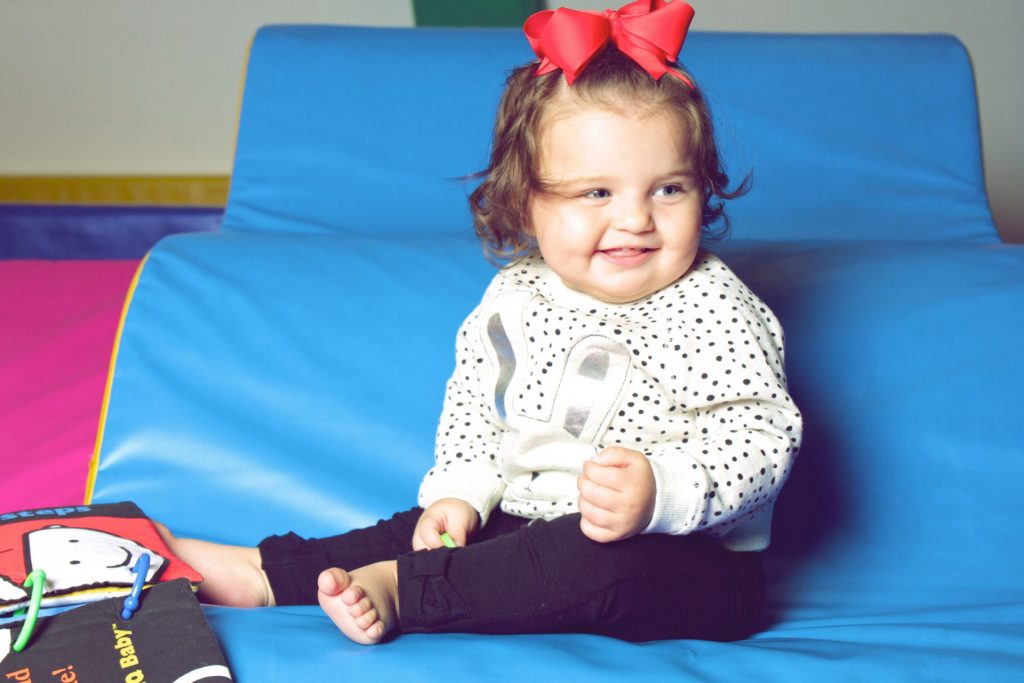Key takeaways
- The stages of learning to sit: 4-6 months, 7-9 months, 10-12 months
- How to help your baby learn to sit up
- How to help your baby move in and out of sitting
4-6 months
4 months – “Developing head control”
- Lying on their backs, babies can bring their hands up to their knees – strengthens hips and tummy muscles.
- On their tummies, they push up on to elbows and lift head and upper chest – strengthens back and tummy muscles.
- When pulled to sit from their backs, they control their head position on their neck.
5 months – “Lying down sit”
- Babies learn to sit ‘lying down’.
- Can strengthen their legs and lift their arms to their feet – strengthens hip/leg muscles and tummies and shoulders.
- On their tummies, they push onto straight arms – strengthening their legs at their hips, strengthening hips, back, and tummy muscles.
- When on your lap, they can lift their head and play with a toy in their hands.
- When placed in a sitting position, will prop up on their hands for a few seconds.
- Sit up in a pram.
6 months – “Prop sit”
- They are moving from back to their tummies, showing increasing voluntary muscle control and strength.
- Babies on their tummies are adopting the ‘Superman position’ – legs and arms off the floor and arching their backs to ‘fly’.
- Lift their head up when pulled to sit.
- Sit independently with their legs in a swimming position for stability.
- Can prop forwards on their hands if they lose their balance, but not to the sides.
- Can hold a toy if given.
- Still needs pillows for protection.
- Sits in highchair for feeding – good head and trunk control to allow for swallowing efficiently.

7-9 months
7 months – “Transitional movements”
- Babies dislike their backs.
- Will pull themselves to sit using your hands. (Hip flexor and tummy control).
- Many babies will be adapting to many positions: on their tummies, pivoting, crawling, bear stand.
- Your baby will sit independently.
- Can reach for a toy and maintain balance.
- Still have their legs in a ‘ring sitting’ (sitting with legs in a wide base) for balance.
- May begin to move forwards over the legs towards an ‘all fours’ position.
8 months – “Transitional position I”
- Busy, active, moving in/out of sitting.
- Difficult to change their nappies as they want functional independence.
- Your baby will be moving with all fours to crawl or go to sit.
- Will use ‘ring sitting’ leg position while sitting while playing.
- Develops trunk rotation and side sit – able to maintain balance and reach for a toy.
- Moves from sit to ‘all fours’ due to increasing control of trunk and legs.
9 months – “Transitional position II”
- Trunk control in sitting well developed.
- Often a transitional position as they explore their environment.
- Can hold objects as they move freely in and out of sitting.
- Variety of positions of legs.
- May begin to move from sitting to kneeling.

10-12 months
10 months – Play position
- Rarely sit still.
- If sitting still, they are eating, or exploring toys, beginning to put things in and out of containers.
- Beginning to mimic gestures in sitting, i.e. ‘Ta (thank you)’.
- Constantly transitioning from ‘ring sit’, to long leg, to side sit, to ‘W-kneeling’, to kneeling.
- They transition in and out of all sitting positions easily and do not use any one position persistently.
11 months – Mimicking daily activities
- Assists with dressing while in sitting.
- Two-handed play in sitting, with one hand holding and one hand moving.
- Trunk rotation and reach outside of their base and remaining stable.
- Brief periods of sit while transitioning to crawl.
- Sitting in boxes, up on chairs/coffee table, etc.
12 months
- Active and independent.
- Moving in and out of sitting constantly.
- Transitions easily from sit to crawl, to kneeling, to squat, and up to stand.
- Increasing complexity of play.

The emergence of early head control at 4 months is the steppingstone to sitting by 8 months and up to stand by 12 months.
How to help your baby learn to sit up
Help them strengthen their back and tummy muscles through movement and play:
- Help them roll.
- Vary the position they are in.
- Play “Row, row, row your boat” to do mini sit-ups.
- Demonstrate mini push-ups on their tummies.
- Put toys just out of reach when you prop your baby in sitting.
- Put toys up on low cushions to help develop back strength.
- Encourage them to reach up and play with their feet.
- Put cushions in front of them to lean on.
Once your baby sits alone
- Place toys out of reach to encourage rotation and strengthen side tummy muscles for movement.
- Encourage them to reach up.
- Help your baby come forwards on their legs into side sit.
- Give them 2 toys to play with and encourage bimanual play.
- Sing songs with gestures.
- Play movement songs in sit to encourage propping/movement.

What to do if your baby doesn’t sit up
If they don’t hold their head up at 4 months, prop on their arms by 4-5 months, and can’t sit by 9 months, check with your doctor or a paediatric physiotherapist.
All babies are different in their learning styles. Some are quiet, while others are movers. Developing head control and trunk strength is key to sitting independently. Sitting is a key to moving in and out of crawling, kneeling, and standing.
Keep safe, happy, and well,
Deb




